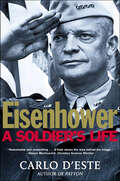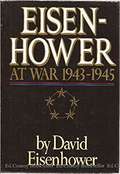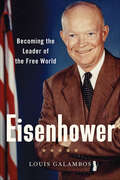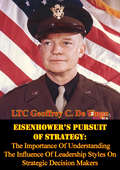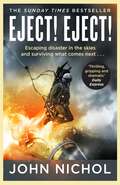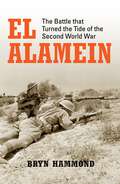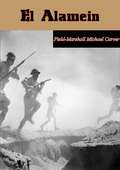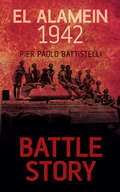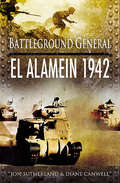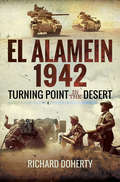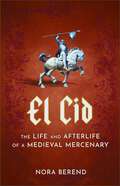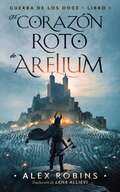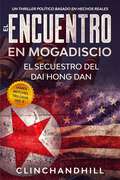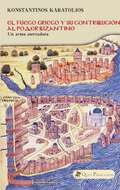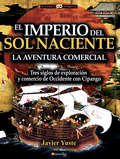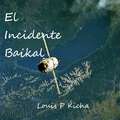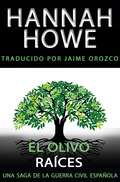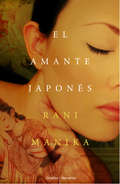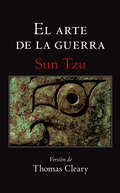- Table View
- List View
Eisenhower: A Soldier's Life
by Carlo D'EsteThe acclaimed biographer presents an intimate and comprehensive portrait of the legendary president and WWII general: “An excellent book.” —The Washington Post Book WorldBorn into hardscrabble poverty in rural Kansas, the son of stern pacifists, Dwight David Eisenhower graduated from high school more likely to teach history than to make it. Yet he went on to become one of America’s most important military leaders. Then, on the wings of victory, the career soldier ascended to the nation’s highest political office. Casting new light on this profound evolution, Carlo D’Este chronicles the unlikely, dramatic rise of the supreme Allied commander.With full access to private papers and letters, D’Este has exposed for the first time the countless myths that have surrounded Eisenhower and his family for over fifty years. In this revealing biography, he identifies the complex and contradictory character behind Ike’s famous grin and air of calm self-assurance.
Eisenhower: At War 1943-1945
by David EisenhowerThe first volume of a multi-volume study of President Eisenhower, this book focuses on Eisenhower's conduct of the war and provides an extensively documented analysis of the political ramifications of the course of the war and Eisenhower's decisions
Eisenhower: Becoming the Leader of the Free World (The\papers Of Dwight David Eisenhower Ser.)
by Louis Galambos"Highly accessible and sprightly written."—Library JournalWinner of the Kansas State Library's Kansas Notable Book AwardIn this engaging, fast-paced biography, Louis Galambos follows the career of Dwight D. "Ike" Eisenhower, offering new insight into this singular man who guided America toward consensus at home and a peaceful victory in the Cold War.The longtime editor of the Eisenhower papers, Galambos may know more about this president than anyone alive. In this compelling book, he explores the shifts in Eisenhower's identity and reputation over his lifetime and explains how he developed his distinctive leadership skills. As a career military officer, Eisenhower's progress was uneven. Galambos shows how Ike, with the help of Brigadier General Fox Conner, his mentor and patron, learned how to profit from his mistakes, pivot quickly, and grow as a military and civilian leader. On D-Day, Eisenhower guided the largest amphibious force in history to a successful invasion of France and a decisive victory. After the defeat of Nazi Germany, he turned to politics and was elected president in 1952.While today's fiercely partisan political climate makes it difficult to imagine a president forging consensus in Washington, that's exactly what Eisenhower did. As America's leader in an era of profound postwar changes at home and abroad, President Eisenhower sought a middle way with compromise and coalition building. He provided his country with firm-handed leadership, bringing prosperity and peace to the American people in the dangerous years of the Cold War—an accomplishment that made him one of the most influential men of the twentieth century. Destined to be the best short biography of the thirty-fourth president of the United States, Eisenhower conclusively demonstrates how and why this master of the middle way became the successful leader of the free world.
Eisenhower’s Pursuit Of Strategy: The Importance Of Understanding The Influence Of Leadership Styles On Strategic Decision Makers
by LTC Geoffrey C. De TingoEisenhower preferred to build consensus for his military and national strategies by using multiple communication techniques to convey his intent. If consensus was not achieved, though, and his intent was not carried out he would aggressively move to eliminate the source of friction. This monograph will analyze four case studies to demonstrate that it is critically important for subordinates and peers to understand the influence of leadership styles on strategic decision makers. It will also argue that the consequences for not understanding strategic decision makers can mean the difference between individual, organizational or national success or failure.The four case studies will highlight the leadership styles that Eisenhower used when he pursued a strategy and how those leadership styles influenced his decision-making. The first case study is Eisenhower's fight to control Allied strategic bombers to support Operation Overlord in 1944. Second is his fight to develop, implement and defend his New Look National Security Strategy in 1953. Third is how Eisenhower defended his administration's Middle East foreign policy and finally his strategy to seek a peaceful solution to the Suez Canal Crisis of 1956.
Eisenhower’s Six Great Decisions: Europe, 1944–1945
by General Walter Bedell SmithEisenhower's Chief of Staff reviews the six turning points of the European war that took the Allies from Normandy to the heart of Germany in only 11 months.War, as in life, turns on decisions taken and opportunities taken; the decisions of General Eisenhower as supreme commander of the Allied effort in Europe shaped the lives of millions of soldiers and tens of millions of civilians. The strain of these decisions was shared with many of the top allied commanders, but few will have understood Eisenhower's thought processes than his trusted friend, confidante and chief of staff General Walter Bedell "Beetle" Smith. A shrewd and intelligent man in his own right, the "Beetle" would be constantly by Eisenhower's side as he directed the huge Allied armies against the Wehrmacht across France, Belgium, Holland and finally into Germany itself. He set out to describe the events through the eyes of his friend and superior as they appeared at the time; the six 'Great Decisions' that he decided on as the turning points of the conduct of the war were:1 - The Decision Of The Timing Of Operation Overlord [The Normandy Landings]2 - How To Break Out Of Normandy Bocage3 - How To Deal With The Ardennes Counteroffensive [Battle Of The Bulge]4 - How To Destroy Or Capture All German Forces Against The West Of The Rhine5 - How To Encircle The Industrial Heartland Of Germany - The Ruhr.6 - How To End The War.A must read for anyone interested in the Second World War.
Eject! Eject!
by John Nichol'Eject! Eject!' When the call is made to abandon an aircraft, it's only the beginning of the story... From the Sunday Times bestselling writer John Nichol, author of Spitfire, Lancaster and Tornado, comes a brilliant new book that reveals the astonishing story of an invention that has saved many thousands of lives around the world, including his own: the ejection seat. Nichol tells the remarkable tale of how the ejection seat was first conceived during the Second World War as countless lives were lost in accidents and in battle. In the wake of the war, that technological race to save aircrew lives using explosive seats continued at an incredible pace. Nichol tells the story of the brave men who risked their lives testing those early devices, and interviewed the first British pilot to eject back in 1949, when ejection, from pulling the handle to being under the parachute, took thirty seconds. Today, that figure is down to around one second. Packed with interviews with aircrew who know exactly how it feels to &‘Bang Out&’ from an aircraft at high speed, both in peace and in war, the book gives the reader a vivid sense of what that life-saving experience feels like, but also features the moving accounts of what happens next, from the viewpoint of both the crews and their families, who often have little or no information about whether or not their loved ones have survived. Because ejecting is just the start of a journey….. Packed with dramatic action, incredible science and moving recollections, Eject! Eject! is an essential read.
El Alamein
by Bryn HammondThe battle of El Alamein in 1942 was one of the most crucial events in the entire Second World War. Before it, the British had never won a major battle on land against the Germans; nor indeed had anyone else, even the Russians. At Alamein the British Eighth Army first thwarted the Axis attempts in North Africa to seize Cairo and the Suez Canal and then smashed through the German-Italian defences, eventually driving the Axis forces out of North Africa. This victory, by a 'British' army actually composed of a variety of nationalities including men and women from the Indian sub-continent, southern Africa, Australians, New Zealanders, French and Greeks, as well as British troops, had psychological and morale-raising significance that exceeded even its strategic importance. Nothing had the sweet smell of success prior to this battle than El Alamein and for the battered British Empire battling against the might of the Third Reich this victory was crucial to its ability to continue its war efforts. El Alamein's significance went beyond the events of the war. The opposing army commanders were perhaps the first 'celebrity' generals, attracting the attention of press and newsreel reporters alike. This led to a host of myths and tales of idiosyncratic behaviour that were shamelessly exploited by the individuals themselves and, especially in Britain, eagerly devoured by a public enamoured of the romance of warfare in this remarkable and hostile environment where men were at war with each other as well as with the elements. Drawing on a remarkable array of first-hand accounts, this book reveals the personal experiences of those on the frontline, giving the individual's point of view of the battle, from all sides, and provide a fascinating account of the minutiae detail of how war was actually fought alongside the analysis of the strategic decisions made by the generals. El Alamein 1942 is the story of exactly how a seemingly beaten and demoralized army turned near-defeat into victory in a little over four months of protracted and bloody fighting in the harsh North African desert and of the repercussions of the battle for the participants, for historians and in popular culture.
El Alamein
by Field-Marshal Michael CarverThe Second Battle of El Alamein (23 October - 11 November 1942) was a decisive battle of the Second World War that took place near the Egyptian railway halt of El Alamein and marked the watershed of the Western Desert Campaign. In August 1942, Lt.-Gen. Sir Bernard Law Montgomery took command of the 8th Army, and the British victory turned the tide in the North African Campaign, ending the Axis threat to Egypt, the Suez Canal and the Middle Eastern and Persian oil fields via North Africa.The Second Battle of El Alamein revived the morale of the Allies, being the first major success against the Axis since Operation Crusader in late 1941. The battle coincided with the Allied invasion of French North Africa in Operation Torch, which started on 8 November, as well as the Battle of Stalingrad and the Guadalcanal Campaign.This book, first published in 1962, provides a detailed account of the Second Battle of El Alamein, based on original German and British sources and drawing on the author’s own observations as one of the combatants.
El Alamein 1942
by Pier Paolo BattistelliThe Second Battle of El Alamein was one of the most decisive Allied victories of the Second World War. The Second Battle of El Alamein marked a major turning point in the Western Desert Campaign of the Second World War. El Alamein saw two of the greatest generals of the war pitted against each other: Rommel and Montgomery. Through key profiles and a chapter devoted to “The Armies,” El Alamein 1942 explores what made these men inspired leaders and what led to their respective defeat and victory. Montgomery’s success ensured that the Axis army was unable to occupy Egypt and therefore gain control of the Suez Canal or the Middle Eastern oil fields, thereby preventing a major source of income and power coming to them. The background and impact of the battle are explored in separate chapters, offering the reader clear insight into why what happened in this remote part Egypt was so central to the Allied cause. Through quotes and maps, the text explores the unfolding action of the battle and puts the reader on the front line. If you truly want to understand what happened and why — read the Battle Story.
El Alamein 1942: El Alamein 1942
by Diane CanwellThe Battlefield General game books put you in command of the forces engaged in some of history's most famous battles. Your ability to make the right tactical decision will be tested at every turn of the page. The 2nd Battle of El Alamein in October 1942 was one of the crucial turning points of WWII. Here Lieutenant General Bernard Montgomery ('Monty') and the British Eighth Army (the famous 'Desert Rats') halted the victorious advance of Field Marshal Erwin Rommel (the Desert Fox) and his Afrika Korps. Britain's vital interests in the Middle East, particularly the vital oil fields, were thus saved. The book presents the reader with a series of command decisions, aided by situation maps, directing you to the next relevant briefing depending on the option you choose. No dice are necessary to play, just this book and your tactical skill. When you buy this book, the fate of nations is in your hands.
El Alamein 1942: Turning Point in the Desert
by Richard DohertyThe Battle of El Alamein is well established as a pivotal moment of the Second World War. Following the wildly fluctuating fortunes of the opposing sides, there was a real risk that Rommels Afrika Korps and his Italian allies would break through and seize Cairo with catastrophic strategic and political implications for the Allies. That this never happened is, of course, well known but, as this highly readable yet authoritative work reveals, there were moments of extreme peril and anxiety.Churchills bold, nay desperate, decisions concerning key appointments, Montgomerys stubborn refusal to be rushed, Rommels chronic logistic problems and critical air superiority are all examined in expert detail. The authors description of the actual fighting is brought to life by personal accounts as well as his complete grasp of the plan and tactics involved.The result, seventy-five years on, is a delightfully fresh and fascinating account of one of the iconic battles, not just of the War but in military history.
El Cid: The Life and Afterlife of a Medieval Mercenary
by Nora Berend'A fascinating study of historical mythmaking... Concise and absorbing'Paul Freedman, author of Out of the EastRodrigo Díaz lived a violently colourful life in eleventh-century Spain. An ambitious military leader, exile and brutal mercenary, he served Christian kings, fought against Christian princes in service of Muslim rulers, raided and killed Muslims and eventually struck out on his own, carving out an independent principality. While Rodrigo the man is long dead, El Cid lives on: a superhero; a quasi-saint; the 'spirit of Spain', according to military dictator Franco; and a champion of medieval Spanish multiculturalism. Nora Berend uncovers how el Cid has been transformed across the centuries, confronting the gulf between truth and legend and examining how a military adventurer became a hero to people on opposite ends of the political spectrum. What is it about this man that appeals to us? And why do we transform the most unsuitable people into heroes?'Would the real El Cid please stand up? Nora Berend's fascinating new book covers nearly a thousand years of history and myth-making about this eleventh-century warrior . . . and presents all the delicious ironies of history'Professor Marc David Baer, author of The Ottomans: Khans, Caliphs, and Caesars
El Cid: The Life and Afterlife of a Medieval Mercenary
by Nora Berend'A fascinating study of historical mythmaking... Concise and absorbing'Paul Freedman, author of Out of the EastRodrigo Díaz lived a violently colourful life in eleventh-century Spain. An ambitious military leader, exile and brutal mercenary, he served Christian kings, fought against Christian princes in service of Muslim rulers, raided and killed Muslims and eventually struck out on his own, carving out an independent principality. While Rodrigo the man is long dead, El Cid lives on: a superhero; a quasi-saint; the 'spirit of Spain', according to military dictator Franco; and a champion of medieval Spanish multiculturalism. Nora Berend uncovers how el Cid has been transformed across the centuries, confronting the gulf between truth and legend and examining how a military adventurer became a hero to people on opposite ends of the political spectrum. What is it about this man that appeals to us? And why do we transform the most unsuitable people into heroes?'Would the real El Cid please stand up? Nora Berend's fascinating new book covers nearly a thousand years of history and myth-making about this eleventh-century warrior . . . and presents all the delicious ironies of history'Professor Marc David Baer, author of The Ottomans: Khans, Caliphs, and Caesars
El Corazón Roto de Arelium (Guerra de los Doce #1)
by Alex RobinsAlgunas cosas nunca deben olvidarse. Hace más de 400 años, doce grandes guerreros unieron los asediados ejércitos de hombres y recorrieron las tierras devastadas por la guerra, empujando al enemigo hacia los pozos y cavernas subterráneas de donde venían. Con el propósito de asegurar su legado, cada uno de los Doce fundó monasterios-fortalezas para impartir su conocimiento único de la guerra y la política a unos pocos, los Caballeros de los Doce. Ahora, el último de los Doce ha pasado de la historia a la leyenda y las menguadas órdenes de los Caballeros albergan un oscuro y terrible secreto que debe ser protegido a toda costa. Merad Reed, anhela escapar de la sombría y monótona realidad que lo ha tenido cautivo la mitad de su vida protegiendo un gran cráter conocido como El Foso. La llegada de Aldarin, uno de los pocos Caballeros de los Doce que quedan, precipitará una cadena de eventos cataclísmicos que transformaran a Reed para siempre. Al norte, Jelaïa del Arelium, heredera de la más rica de las nueve baronías, debe aprender a navegar por las turbulentas corrientes políticas de la corte de su padre, si espera algún día ocupar su lugar. Pero las llamas parpadeantes de la ambición esconden la sombra de una amenaza aún mayor. Y en lo profundo de la tierra, algo se mueve.
El Encuentro en Mogadiscio: El Secuestro del Dai Hong Dan (James Mitchel trilogía No. 3 #3)
by ClinchandhillA medida que aumentan las sospechas de un cargamento muy peligroso a bordo del Dan, Mitchel y sus colegas nos llevan a un emocionante viaje en el que el peligro y la amenaza de una guerra nuclear son inminentes. El Encuentro de Mogadiscio es la última aventura de la trilogía de James Mitchel, inspirada en hechos reales. Clinchandhill vuelve a unir realidad y ficción, drama y diálogos que mantendrán al lector atado al libro de principio a fin.
El Fuego Griego y su contribución al poder bizantino
by E2e Konstantinos KaratoliosUna maravilla como el Imperio Bizantino de los mil años no podría haber sido lograda sin sus fuerzas armadas, que le permitieron mantener su poder frente a los constantes retos que le presentaban enemigos externos de naturalezas significativamente diferentes. En un contexto así, lo heredado de los romanos era tan importante como la adopción de nuevas armas y tácticas de batalla. El Fuego Griego, pese a no ser la más importante arma, era ciertamente la que más fama cosechó. Fue utilizada en todo el imperio ayudando a conseguir espectaculares victorias a su marina. Este arma aterradora marcó época, y pese a ello todo lo que sabemos sobre su historia se encuentra difuminado por la vaguedad de los escritos contemporáneos. En este trabajo, Konstantinos Karatolios trata de responder una serie de preguntas relacionadas con el Fuego Griego: ¿Cuál era la fórmula? ¿Qué efectividad poseía? ¿Quién es su verdadero creador? ¿Cómo se utilizaba en batallas de tierra y mar? Este libro trata de no solo ofrecer una visión breve y global sobre el estado actual de las investigaciones que puede ser fácilmente leída por no especialistas, haciendo al mismo tiempo una contribución a su estudio respetando los métodos de investigación académicos.
El Imperio del Sol Naciente (Historia Incógnita)
by Javier Yuste GonzálezTres siglos de exploración y comercio de Cipango con Occidente. 1542-1868: 300 años de contactos culturales y comerciales de Cipango con occidente: Desde el shogunato y la reunificación de Japón por Nobunaga, Toyotomi y Tokugawa hasta la restauración del poder imperial. Historias, aventuras, exploraciones y conflictos bélicos. La apasionante historia de la modernización del fascinante Japón.Conozca la narración apasionante de las historias, aventuras y desventuras protagonizadas por aquellos hombres que, zarpando desde puertos andaluces y lisboetas, desde Ámsterdam, Londres y otros tantos lugares, quisieron llegar hasta la mítica Cipango que Marco Polo describió en el s. XIII; unas islas pobladas por los hombres del Oriente dotados de un nivel culturals superior y rodeados de riquezas tales que solo el sol podría haber creado. Una obra que recoge de forma exhaustiva más de tres siglos de contactos culturales y mercantiles, con sus sombras y sus luces, con abrazos fraternales y odios exacerbados. Una etapa clave de la humanidad, en plena conquista y descubrimiento de todas las tierras ocultas; de afán por saber qué se ocultaba en aquellos espacios en blanco que poblaban los mapas, en los que tan solo se leía la leyenda de Terra Incognita y sinuosos dragones se coronaban como únicos reyes y señores. Si se atreve a pasar de la primera página, se verá trasladado a 1542 a bordo de un junco chino junto a Fernán Mendes Pinto, así como, a bordo de un moderno navío de guerra americano en 1853. Y, entre tanto, presenciaremos el buen entendimiento entre japoneses y españoles, hasta que este salte en miles de pedazos bañados en sangre, que sirve de tinta para un mensaje de advertencia dirigido al rey Felipe IV. Más que historia es la aventura en pos de conocer nuestros vínculos originales con una tierra que, aún a día de hoy, sigue sorprendiéndonos.
El Incidente Baikal
by Louis KichaUn thriller de espías que abarca cuatro décadas. En 1970, un avión espía que transportaba una mortífera arma secreta se pierde sobre la Unión Soviética; se desconoce su ubicación. Cuarenta años después, se descubre en las profundidades del lago Baikal de Rusia. La carrera por recuperar la terrible arma antes de que caiga en manos del enemigo está en marcha.
El Olivo; Raíces: Una Saga de la Guerra Civil Española (El Olivo #1)
by Hannah HoweEnmarcado en el periodo de tiempo de abril de 1937 a Diciembre de 1938, El Olivo es una colección de mini-series de cinco novelas basadas en hechos reales. Las historias de El Olivo – Raíces, Ramas, Hojas, Fruto y Flores – narran la vida de Heini Hopkins, una enfermera joven de una empobrecida parte de Gales del Sur, y Naomi Parker, una autora rica de un privilegiado estrato social. En Raíces, Heini está en casa cuidando de su madre enferma en Gales, mientras Naomi asiste a presentaciones de su más reciente novela. La guerra civil en España parece un mundo aparte, hasta que los fascistas bombardean y destruyen Guernica, acabando con la vida de miles de hombres, mujeres y niños. El novio de Heini; Deiniol Price, es un hombre que trabaja en una mina de carbón que tiene la mirada puesta en ayudar a la causa de la Republica Española, buscando colaborar como voluntario en Brigadas Internacionales, mientras que el amante de Naomi; el conde Nicolas Esteban, es un piloto que sueña con la gloria de luchar junto los fascistas. ¿Qué destino les aguarda a Heini y Naomi si deciden seguir a sus hombres dejando la seguridad de Gales para adentrarse en los sangrientos campos de batalla en España?
El Paso Sunset: A Novel (The El Paso Novels)
by Louis BodnarThe Second American Civil War rages in the explosive saga that delivers “ruthless action, dark comedy, betrayal, love, and several strong friendships” (Lone Star Reviews).Following the unexpected cliff-hanger ending of the wildly successful and acclaimed four-state regional bestseller, El Paso Sunrise, the much anticipated El Paso Sunset continues the Steven Vandorol story . . .During the ultimate crisis of a Second American Civil War started by dark, sinister, and shadowy forces, only Steven and his friend, Vanessa Carson, stand in the way. But they face their worst nightmares of rape, kidnapping, and murder. El Paso Sunset is the second of two stand-alone novels that together make a story of love, passion, obsession, intense hate, pure evil, violence, and horror, all brought keenly alive against the panorama of the radical transformation of the great American Constitutional Republic.
El Vuelo de Violetta: Kahbia
by David Richard BeasleyUna joven birmana escapa de los japoneses en la Segunda Guerra Mundial. Los ejércitos japoneses invadieron una Birmania casi indefensa en 1942, enviando a decenas de miles de personas a huir por las montañas hacia la India. Ellos gobernaron a los birmanos restantes, ante quienes alardearon de liberarlos del dominio británico, con arrogancia y brutalidad. "El vuelo de Violeta" narra las experiencias de una joven anglo-birmana y sus parientes creciendo felices bajo los británicos y su terrible experiencia escapando de los japoneses, viviendo bajo la ocupación o luchando en la resistencia. Las batallas ganadas por los ejércitos aliados que salen de la India para retomar Birmania en 1944-45 son vistas a través de los ojos de los oficiales japoneses, que ven a sus ejércitos sufrir a su vez las agonías de la derrota en la guerra. Las semillas del fascismo sembradas por Aung San y su Ejército de la Independencia de Birmania uniéndose a la invasión japonesa, hasta desencantarse, crecieron como una hierba que envenenó a la sociedad birmana contra los anglo-birmanos y otras etnias, impidiendo su florecimiento con una dictadura de puño de hierro.
El amante japonés
by Rani ManickaCon la exuberante Malasia invadida por el ejército nipón como telón de fondo, la sensualidad de una mujer convertida en geisha en manos de un oficial japonés se transforma en una apasionante historia de amor prohibido en tiempos de guerra. Una mujer, un oficial enemigo y un amor que nadie podría sospechar. En Malasia, en los albores de la Segunda Guerra Mundial, tras un matrimonio concertado, Parvathi vive sin grandes alicientes en la opulenta mansión de su marido, un hombre mucho mayor que ella que prácticamente la desprecia. Solo gracias a la ayuda de una cocinera llena de sabiduría y a un criado que la ama en secreto, Parvathi logra seguir adelante. Pero la invasión japonesa del país cambia su vida ya que, tras el saqueo y la ocupación de su propio hogar, Parvathi se ve obligada a convertirse en la geisha y amante del oficial japonés al mando. Sin embargo, lo que empieza como el mayor de los sacrificios pronto se transforma en un amor prohibido que hará surgir en ella sensaciones que jamás había experimentado. Tal vez un amor que puede ir más allá de las fronteras de la guerra. La historia de amor prohibido entre una mujer convertida en geisha y un oficial japonés es el hilo argumental de la conmovedora novela con la que Rani Manicka confirma el merecidísimo éxito de su novela anterior, Madre del arroz. Reseñas:«Una novela fascinante y conmovedora en la que Rani Manicka, la autora del gran éxito Madre del arroz, recrea una épica historia de amor, pérdida y destinos universales.»Publishers Weekly «Una lectura maravillosa, realista y llena de color.»Choice «Una historia de amor alejada de cualquier convencionalismo y narrada con gran imaginación que nos traslada a un pasado exótico habitado por personajes asombrosos.»She
El anillo (Nueva Fontana Ser.)
by Danielle SteelUna historia de amor y lucha frente a las adversidades ambientada en la Alemania de la Segunda Guerra Mundial. En una Alemania inmersa en la guerra y el odio, la joven Ariana von Gotthard recibe el más preciado legado familiar: un anillo. Este se convertirá en símbolo del hogar perdido, pues tras ser separada de su familia, y sin posibilidad de escapar del país, Ariana es arrestada por los nazis. El amor, sin embargo, la salva de las más sombrías perspectivas y le brinda la oportunidad de huir al extranjero. Un viaje no exento de tragedias conduce a Ariana a Estados Unidos, hacia una vida incierta entre gente desconocida y temores nuevos. Ariana queda reducida a una mujer sin pasado y sin futuro, y el anillo al que todavía se aferra es el único recuerdo que guarda de su padre y su hermano. Lo que no sabe es que, con el paso del tiempo, el anillo le servirá como puente entre lo que dejó atrás y el provenir.
El arte de la guerra (Clásicos Ilustrados Ser. #Vol. 1)
by Sun Tzu Thomas ClearyRecopilado más de dos mil años atrás por un misterioso guerrero filósofo, El arte de la guerra sigue siendo, quizás, hoy en día, el libro de estrategia más prestigioso e influyente del mundo, estudiado en Asia por políticos modernos y ejecutivos con el mismo entusiasmo con el que fuera consultado en tiempos antiguos por jefes militares. Como estudio de la anatomía de las organizaciones en conflicto, El arte de la guerra se aplica en general a la competencia y al conflicto, en todo nivel, desde el interpersonal al internacional. Su objetivo es la invencibilidad, la victoria sin dar batalla, y la fuerza inexpugnable gracias a la comprensión de la física, la política y la psicología del conflicto. Compiled more than two thousand years ago by a mysterious warrior-philosopher, The Art of War is still perhaps the most prestigious and influential book of strategy in the world today, as eagerly studied in Asia by modern politicians and executives as it has been by military leaders since ancient times. As a study of the anatomy of organizations in conflict, The Art of War applies to competition and conflict in general, on every level from the interpersonal to the international. Its aim is invincibility, victory without battle, and unassailable strength through understanding of the physics, politics, and psychology of conflict.
El baile de las marionetas
by Mercedes GuerreroUna historia de amistad, de supervivencia, de personajes entrañables, de lealtades inquebrantables, amores imposibles y traiciones imperdonables. Afganistán, 2004. La doctora Edith Lombard, de Médicos Sin Fronteras, hace guardia en un hospital de Kabul. Al atender a una joven en quirófano advierte en su cuello algo que atrae su atención: un collar del que cuelga una perla de ámbar. Una perla que Edith reconoce enseguida, pues fue robada en su casa de Quebec dieciocho años antes, en un atraco en el que su madre falleció de un disparo. Una perla de la que su padre, Édouard Lombard, había contado que perteneció a la famosa Cámara de Ámbar de San Petersburgo, desparecida durante la II Guerra Mundial. Bilbao, 1937. Del puerto de Santurce está a punto de zarpar el Habana, que llevará a más de cuatro mil niños hasta la Unión Soviética, huyendo de la guerra civil que ahogaba el país. Allí, su historia, la historia de unos exiliados utilizados como marionetas por el gobierno de Stalin, se hilvanará con la de la perla de ámbar en un viaje de setenta años que desempolvará recuerdos que nadie quería que viesen la luz.
